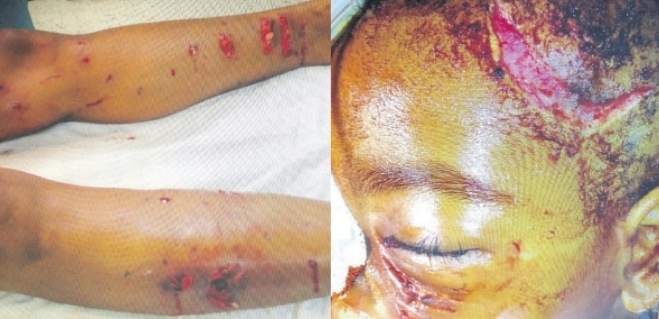INJURIES resulting from dog bites are putting a strain on public health facilities, one of the country’s leading plastic and reconstructive surgeons has said.
In fact, Dr Guyan Arscott shared information during a presentation at the Observer head office on Beechwood Avenue in St Andrew last Friday which revealed that it is the Government, and in particular the Ministry of Health, that is left with the bill for treatment of dog bite injuries.

Arscott’s presentation comes amid calls to amend century-old legislation pertaining to dogs following the death of 66-year-old Whittington Cole. The elderly man was walking in his Hampton Green community in St Catherine last month when he was mauled by four dogs believed to be pit bulls and rottweilers.
“For some years now we’ve had challenges in the public health sector, particularly in our main public hospitals, when we have to manage these injuries that present most commonly as an acute emergency at both the adult public hospitals and the paediatric hospitals,” Dr Arscott said.
“All of these injuries that we see that are a burden on the public purse, for the most part, are preventable. So whatever we do, we must have prevention as a fundamental basis, and I would implore the Ministry of Health that when we are targeting social health issues like these preventable traumatic injuries, we must find ways and means to enhance our approach to prevention,” the plastic surgeon added.
According to the consultant, of all the dogs that can at any time deliver a bite to the human body, two stand out: pit bulls and rottweilers.
“When you look at the data, about 32,000 fatal attacks [globally] were reported as a result of dogs in the year 2009. In the United States, there were 800,000 dog bites per year that required medical attention. I think that number is probably higher now. Of these figures, the pit bulls are on top, followed by rottweilers, German shepherds, doberman pinschers, and huskies,” said Arscott.
He told the Observer that the available data show that pit bulls and rottweilers are more likely to attack without warning.
“Their aggressive behaviour is genetically predetermined. There is good evidence that their genes allow that type of aggression, and so they will fight even without provocation. We know that there is talk about provocation and the result of provocation, but these two will fight without provocation. Even in the hands of responsible owners they are prone to dangerous behaviour… Even the owners are prone to the attack of these dangerous animals and so we have concluded that nature cannot be overcome by nurture,” he said. “No matter how you care for them, there is the high possibility that you’ll be attacked by the rottweiler or the pit bull at some point.”
According to Arscott, 75 per cent of the global figure for dog attacks in 2009 was by pit bulls and rottweilers. Equally, Arscott said, 75 per cent of attacks take place on the owner’s property. Sixty per cent of these attacks are on children, he said.
“These dogs have and will kill members of our population. When we look at some of our cases, patients presenting to the Bustamante Hospital for Children and the University Hospital of the West Indies, we looked at a period — 2006, 2007, 2010. We had 159 patients presenting to our accident and emergency department. Fifty-one per cent or 81 of those were children. Forty-seven or 29 per cent were males, and 33 or 20 per cent were females.
“Clearly they are going to demand specialist treatment. The majority of the cases, fortunately, were presented within the first 24 hours, so we were able to carry out the fundamental elements of wound management. Where possible, we would do early wound closure; when it’s more complex, sometimes reconstructive procedures by the plastic surgeons are required,” Arscott said.
Pictures shown to the Observer were too graphic to print, but revealed that one patient, a young boy, was scalped by a pit bull. Another boy’s mouth was bitten off, while an owner’s nose was removed by pit bulls and rottweilers. Another owner’s ear, eye and mouth were severely bitten, destroying her facial nerves, which required replacement to facilitate closure of the eye and eating. Meanwhile, another owner received bites all over her body and required surgery.
“This is what we have to deal with. They attack, what I would say, most times the face and things like genitals and ears. They attack both face and limbs. They are extremely powerful and it is very difficult for you to overcome a pit bull,” he told the Observer.
“This is the dilemma we’re facing why I think it is reasonable for the Government, and in particular the Ministry of Health which has to pay for these. And the Ministry of Agriculture and Ministry of National Security, they have to sit down and draft up serious policies, like other countries have done, to guide in management of these vicious subsection of the dog population.
“Many of the pit bulls, I’m told, were brought into this country to guard the hard drugs in the drug trade. That’s how they got here and now they are causing mayhem all over the city and all over the country. So I think it needs to be looked into,” he said.











